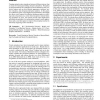Free Online Productivity Tools
i2Speak
i2Symbol
i2OCR
iTex2Img
iWeb2Print
iWeb2Shot
i2Type
iPdf2Split
iPdf2Merge
i2Bopomofo
i2Arabic
i2Style
i2Image
i2PDF
iLatex2Rtf
Sci2ools
VRST
2010
ACM
2010
ACM
Perceiving motion transitions in pedestrian crowds
Creating natural motion transitions between different motion clips is crucial for reusing and editing character animations. Perception of motion transitions in a pedestrian crowd is affected by many collective features such as crowd density, appearance variations, motion variations, and sub-group interaction patterns. In this paper, we conducted a series of psychophysical experiments to investigate how these crowd features can influence human perception on walking motion transitions in a crowd when inexpensive motion blending algorithms are used. Our results provide useful implications and practical guidelines for performance-oriented crowd applications such as real-time games to improve the perceptual realism by effectively disguising motion transitions.
Motion Transitions | Motion Variations | Performance-oriented Crowd Applications | Virtual Reality | VRST 2010 |
| Added | 15 Feb 2011 |
| Updated | 15 Feb 2011 |
| Type | Journal |
| Year | 2010 |
| Where | VRST |
| Authors | Qin Gu, Chang Yun, Zhigang Deng |
Comments (0)

